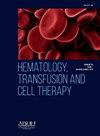CLINICO-BIOLOGICAL PROFILE AND MANAGEMENT OF CHRONIC LYMPHOCYTIC LEUKEMIA
IF 1.6
Q3 HEMATOLOGY
引用次数: 0
Abstract
Objective
Nearly 60%‒70% of patients with Chronic Lymphocytic Leukemia (CLL) are oligosymptomatic at diagnosis. The objective of the study was highlighting the clinical evolution and hematological patterns, as well as the assessment of short- and long-term results of treatment of patients with CLL.
Methodology
We realized a prospective and cohort study. The clinical-hematological features of CLL, the short- and long-term results of therapeutic management were studied in 62 patients, who were treated and followed up in the Institute of Oncology of Moldova between 2019‒2024. The study was related to the outpatient and hospitalized care. The diagnosis was proved according to the IWCLL criteria based on the complete blood count with the detection of lymphocytosis ≥ 5 × 10^9/l, bone marrow aspiration with lymphocytic infiltration ≥ 30% and immunophenotyping. The study was carried out on a basis of the data collected from the outpatient records and from the observation sheets of the patients according to the questionnaire drafted for the achievement of the settled objective. All patients were staged according to Binet and RAI Classifications.
Results
There were 25 (40.3%) males and 37 (59.7%) females in the study group. The age of the analyzed group was between 53 and 87-years (average age – 55.2-years). Forty-two (67.7%) patients with CLL belonged to the age category of 60‒79 years. The ECOG-WHO score at diagnosis was 2-3. Most of the patients (34% or 54.8%) were referred to hematologist in stage A. Twenty-three (37.1%) patients were diagnosed in stage B and 5 (8.1%) – in stage C. Nine (39.1%) cases of autoimmune hemolytic anemia and 8 (34.8%) cases of metaplastic anemia were revealed in stage B. Leukocytosis varied between 88.7‒325.0 × 10ꝰ/l (average value – 161.2 × 10ꝰ/l). Lymphocyte count ranged between 81%‒97% (average value 89%). Bone marrow aspiration in stages A and B revealed lymphocyte expansion of 33%‒91%. The respiratory bacterial infections turned out to be frequently diagnosed (29 patients, or 46.8%): acute pneumonia in 10 (16.1%), acute bronchitis in 7 (11.3%), relapse of chronic bronchitis in 11 (17.7%), and tuberculosis in 1 (1.7%) patient. The patients with progressive stage A, stage B and C disease received combined immuno-chemotherapy. Under the antineoplastic treatment, the ECOG-WHO score improved to 0‒1. Overall survival over 3 and 5 ears was 100%.
Conclusion
Our prospective study of CLL proved a predominance of female gender, patients of 60‒79 years old and stage A at diagnosis. The prognosis emerged to be relatively favorable, with the overall survival rates sustained at 100% within 3 and 5 years.
慢性淋巴细胞白血病的临床生物学特征和治疗
目的慢性淋巴细胞白血病(Chronic Lymphocytic Leukemia, CLL)早期60% ~ 70%的患者在诊断时无明显症状。该研究的目的是强调临床发展和血液学模式,以及评估CLL患者治疗的短期和长期结果。方法采用前瞻性队列研究。本文研究了2019-2024年在摩尔多瓦肿瘤研究所接受治疗和随访的62例CLL患者的临床血液学特征、治疗管理的短期和长期结果。本研究与门诊和住院治疗有关。根据全血计数,淋巴细胞计数≥5 × 10^9/l,骨髓穿刺,淋巴细胞浸润≥30%,免疫分型,诊断为IWCLL。本研究是根据门诊记录和患者观察表收集的数据,根据为实现既定目标而起草的问卷进行的。所有患者均按照Binet和RAI分类进行分期。结果研究组男性25例(40.3%),女性37例(59.7%)。分析组年龄在53 - 87岁之间(平均年龄- 55.2岁)。年龄60 ~ 79岁的CLL患者42例(67.7%)。诊断时ECOG-WHO评分为2-3分。B期23例(37.1%),c期5例(8.1%)。B期出现自身免疫性溶血性贫血9例(39.1%),化生性贫血8例(34.8%)。白细胞水平88.7 ~ 325.0 × 10ꝰ/l(平均值161.2 × 10ꝰ/l)。淋巴细胞计数81% ~ 97%(平均值89%)。A、B期骨髓穿刺显示淋巴细胞扩增33% ~ 91%。常见的呼吸道细菌感染有29例(46.8%),其中急性肺炎10例(16.1%),急性支气管炎7例(11.3%),慢性支气管炎复发11例(17.7%),肺结核1例(1.7%)。进行性A期、B期和C期患者接受免疫联合化疗。在抗肿瘤治疗下,ECOG-WHO评分提高到0-1。3和5穗总存活率为100%。结论我们的前瞻性研究证实,CLL患者以女性为主,年龄在60-79岁,诊断时为a期。预后相对较好,3年和5年的总生存率维持在100%。
本文章由计算机程序翻译,如有差异,请以英文原文为准。
求助全文
约1分钟内获得全文
求助全文
来源期刊

Hematology, Transfusion and Cell Therapy
Multiple-
CiteScore
2.40
自引率
4.80%
发文量
1419
审稿时长
30 weeks
 求助内容:
求助内容: 应助结果提醒方式:
应助结果提醒方式:


